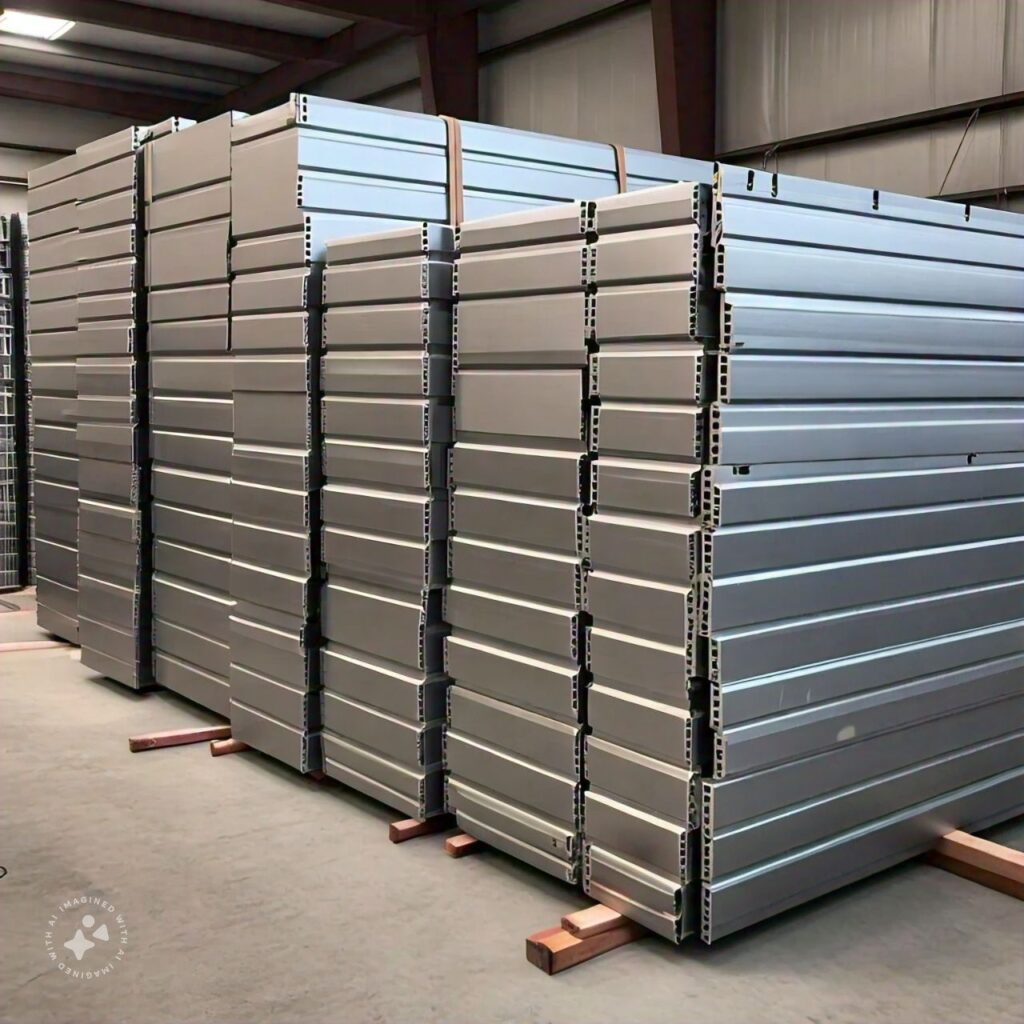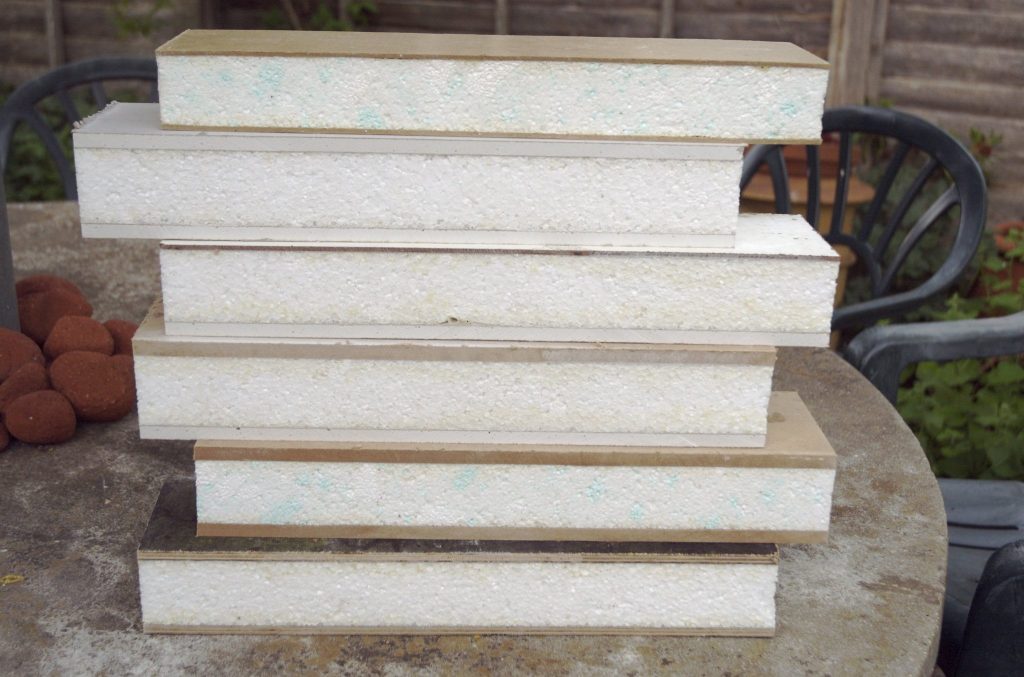Building with Structural Insulated Panels (SIPs) was developed in the 1930s as an alternative home-building technique. Yet, it is hardly known by the general population. Interest in the use of SIPs has been growing in recent years, primarily due to the potential energy savings that SIP homes are promoted as offering.
SIPs consist of an insulating closed-cell rigid foam core sandwiched between two OSB (Orientated Strand Board) facings. The panels are designed to be interlocking, either using splines to connect adjoining panels or nailing the OSB to structural lumber plates. A combination of structural adhesive and nails is used to connect panels together.
You can’t just buy SIPs; they need to be custom-designed and manufactured for your construction project. This starts with the architectural design, which must be done with SIP construction in mind. It’s a good idea to hire a familiar architect to do the design, as designing for SIPs is different from designing for stick construction. While the same designs can be executed, the manner of putting them together is different.
It is critical that a SIP-designed home be well-designed and without any errors in the drawings. Whereas most contractors are accustomed to dealing with problems they encounter in drawings for conventionally built homes and making the necessary modifications on-site, it is often impossible to make those modifications on-site with SIPs, as the panels are prefabricated at the factory. Changes usually require ordering new panels from the factory, adding cost, and delaying the project.
Other areas where errors in the drawings can cause serious problems are in the electrical and mechanical installation in the home. Unlike stick framing, channels for wiring and plumbing must be molded into the panels while they are being manufactured. If they are not, and the tradesmen for these trades must cut channels themselves, there is a high risk of them weakening the panels.
Properly designed, SIP homes can be erected faster, with roughly 50% less labor. While the panels themselves cost roughly 15% more than materials for conventional construction, the labor savings make the overall cost of the home considerably lower.
SIP homes have a life expectancy roughly similar to those of more conventional stick-framed homes, roughly 60 years. This makes it possible to get loans for the construction of these homes and normal conversion to a typical 30-year mortgage.
Benefits of Building with SIPs
As with any building methodology, there are advantages and disadvantages to building with SIPs. People who choose to use this technique generally do so because the advantages appeal to them.
Construction Time
Building with SIPs requires roughly half the labor that normal stick framing does. This not only reduces labor costs, but it also reduces the overall scheduled time required for erecting and drying in the shell of the home. Workers can begin the process of installing electrical, mechanical, and interior finishes sooner, shortening the overall construction time for the home.
Costs
Due to the reduced labor requirement in building the home’s shell, the cost of SIP homes is slightly less than that of stick-framed homes. How much less depends a lot on the specific design of the home. A boxy design is more accessible because of the manufacturing techniques used in making SIP homes. The more deviation from a basic box, by adding areas where sections of the wall protrude or are indented, the more the cost of the home increases.
Insulation
Perhaps the greatest advantage of a SIP home is the insulation it offers. SIP walls have a higher R-value than conventionally built walls, especially if XPS foam is used in the core rather than EPS foam. However, the greater advantage is that the insulation is uniform throughout the design, leaving no difficult gaps to insulate.
In addition, there are fewer points where insulation has to be forgone for structural elements, as the panelized design provides structural strength and insulation throughout. Typical problem places, like the joint between the walls and roof, aren’t a problem with SIP construction.
Airtight
The combination of the laminate construction of the SIPs, splines connecting panels, and adhesives used in the joining of panels provides a highly airtight home. In some cases, this can even be improved by squirting urethane foam into joints in the panels.

A layer of house wrap is applied over the OSB skin of the SIPs, providing an additional airtight seal. Because of the home’s design, this layer of wrap can continue from the walls right over the roof without breaking, eliminating one of the biggest air leak points in any home.
Much of the heat loss in a home is due to air leaks. By creating a more airtight home, there is less loss of heat, resulting in lower heating and cooling costs.
Earthquake and Hurricane Resistance
A finished SIP home is not only nailed together, but bonded together as well, making it stronger than a stick frame home in some critical ways. Some of the places which are typical problem areas, such as the joining of the roof to the walls, have more physical contact, than with stick framing, reducing the risk of earthquakes and hurricanes destroying them.
Disadvantages of Building with SIPs
While there are several good advantages in building with SIPs, there are disadvantages as well. before deciding on SIP construction, you should understand these potential problem areas and either have a plan for dealing with them or make sure that they aren’t going to be an issue for your home. As we are talking about the exterior shell of your home, it’s not like the SIPs can be removed and replaced with something else, if they don’t work out.
Many of the problems can be eliminated by hiring an architect who has a good track record in designing with SIPs and contractors (including subcontractors) who are familiar with working with them. There are a number of potential problems which crop up, for no other reason than using workers who assume that the methods they use in stick framing will also work with SIPs. In some cases, their actions can severely compromise the structural integrity of the home.
Moisture Resistance
One of the main materials used in the manufacture of SIPs is OSB. This is a great engineered wood product, which has been used successfully for decades. However, it is highly susceptible to moisture. If you’ve ever seen a home roof where the edges are curling up, chances are that the roof is sheathed in OSB, rather than plywood.
If a home is being built from SIPs made with OSB and it rains, the OSB will soak up moisture, degrading the panel. The same can happen if the SIPs aren’t correctly spaced off of the foundation. The edges of the OSB panes are the most susceptible to moisture, wicking it up from the bottom which weakens the OSB.
Other materials, including fiber-cement panels, are used in the manufacture of SIPs. Before placing your order, you may want to talk to your architect or SIP manufacturer about your options.
Pest Resistance
The foam core of SIPs is a popular nesting material for pests of all sorts, who will burrow into it to remove it for their nests. Applying insecticides and boric acid during construction can significantly reduce the risk of this problem.
Ventilation Systems
Because SIP-built homes are so airtight, they typically require a smaller HVAC system than stick-framed homes—usually about a ton less. An HVAC engineer who is familiar with building SIP homes would need to calculate and specify this. Additional vents to bring air into the home may also need to be added.
Modifications
Because the panels are factory-made, modifying the home is challenging and expensive once construction has begun. The contractor’s ability to change the panels on the construction site is limited. While there are some things they can do, especially if they are highly experienced in working with SIPs, there are always limitations.
Danger of Structural Damage
Because of their design, SIMs are the structure rather than framing being the structure. They have been designed to meet building code requirements, so that’s not an issue. A problem is if a subcontractor modifies the panels to install electrical wiring, ductwork, or plumbing. A horizontal cut in the panel, creating space for a pipe, can destroy the structural strength of that panel, resulting in your home not meeting building code requirements.
Vertical cuts do not cause this sort of problem, only horizontal ones. The only way to be sure that this risk is properly managed is to select subcontractors who know how to work on an SIP home.
Weight
SIP panels, while lighter than a comparable-sized stick-framed wall, are heavy. Many panels are considerably larger than the 4’ x 8’ panels that most carpenters are used to working with. A crane or forklift is necessary for working with these larger panels, unloading them from the truck, moving them around the job site, and setting them in place.
Design Limitations
While building SIP homes with curved walls and non-standard angles is theoretically possible, manufacturers are not set up for this. Therefore, designs are limited to boxy homes with 90-degree angles.
Fire Safety
Not all SIPs meet the fire safety requirements of the building code. In these cases, a layer of drywall on the inside of the wall is usually enough to ensure that they will meet the requirements. This can be a concern with some architects, who might want to use SIMs without the required layer of drywall for artistic purposes. Unless some other fire-rated product is applied to the walls to protect them, this can create a fire safety issue.
Lifespan
While SIPs are rated at a 60-year lifespan, making them comparable to stick-framed homes, the house’s lifespan can be significantly reduced if they are attacked by moisture. While there are methods to reinforce OSB panels that have been compromised by moisture, they are complex and costly. There is no simple solution that allows the home to be used.

Building with SIPs
Building with SIPs is considerably different from building with stick frame construction. It starts with the panels being fabricated at a SIP manufacturing facility, where the exterior panels and foam core of the sandwich construction are cut and laminated together. Each panel is numbered to match the plans, and the number is painted onto the panel.
Once the panels arrive on the construction site, they are sorted for ease of finding. Walls are assembled by standing the panels on a double wood “plate” (much like the plate at the bottom of a stick-frame wall), with the plate fitting into a channel in the bottom of the panel. The panel is attached to the plate with adhesive and nails spaced every six inches.
From there, adjoining panels with splines are attached to the first. While more than one kind of spline is used, the most common is a piece of OSB that slips into slots behind the OSB on both adjacent panels. It is glued there, and then the panels are nailed together by nailing every six inches through the OSB skins on both sides of both adjacent panels and into the splines.
The wall is finished off by adding a 2”x 4” cap, which sets into a groove at the panel’s top. The ends of these boards must be at least a foot from any joints between panels. Once again, the skins of the panels are nailed to the cap.
Floor structures can be made using the same method as wall panels or traditional wall construction techniques. Roofs are also made of SIPs, allowing for very quick erection and with insulation already built into the roof.
All panels will have channels molded into them to install electrical wiring, plumbing, and HVAC ductwork.



